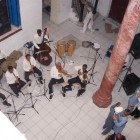Written for the British Flute Society Magazine – PAN: March 2003
Afro
Cuban rhythm popular in the 1930s.
Bolero
A style of Cuban dance music in 4/4 time, which originated at the end of the 19th century in Santiago de Cuba. Originally performed by trova musicians on vocals, guitar bongos and rnaracas, the bolero style is now played by all Cuban line-ups, including the Charanga.
Chachacha
A style created by Enrique Jorrín, bandleader of the Charanga Orquesta América in the 1950s, based on the rhythm of the dancers’ feet: 1, 2, 123 (1, 2, cha-cha-cha).
Danzón
The first style considered to be 100% Cuban. Originally in 2/4 time, the danzón is ‘now played in 4/4 and is made up of a composed introduction, a violin section and later, with the ‘Danzón del Nuevo Ritmo’ in the 1950s, a montuno section with call and response elements borrowed from the son style (this is also known as the mambo section).
Danzonete
Derived from the danzón, this Cuban style originated in the early part of the 20th century and was a sung form influenced by the Cuban ‘son’ style.
Estribillo
The chorus or ‘coro’ sung in the montuno section of arrangements – the main vocalist or instrumentalist improvises responses to these collectively sung coros as part of the call and response element characteristic of all Cuban music (also known as coro-inspiración, coro-guia or coro-pregón).
Guaracha
A vocal style which often has satirical and humorous lyrics, musically close to the son style.
Habanera
This originated in the first I half of the 19th century in Cuba as the ‘contradanza habanera’, the predecessor of the danzón The music is a creolised version of European country dances accompanied by a syncopated rhythm similar to the Argentinian tango.
Mambo
The name given by Arcaño to the final syncopated section of the ‘Danzon del Nuevo Ritmo’. Characterised by repeated instrumental unison riffs against a hard driving percussion section and over a dominant 7th chord, this style was later popularised by Pérez Prado in Mexico and the US.
Montuno
The name given to the pattern played by the pianist, and also the name of the open ‘call and response section’ of an arrangement.
Pachanga
A faster version of the chachachá.
Son
The most famous and influential Cuban style originally played by guitar, tres, vocals, maracas and bongos, it is also now played in other Cuban line-ups.
